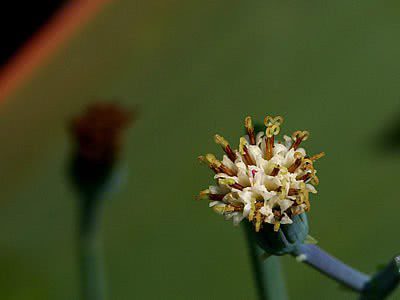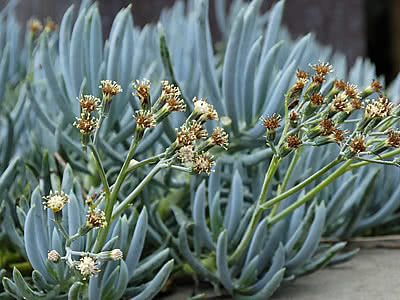The blue chalksticks (Curio repens), also known as blue senecio, is a herbaceous, succulent, and perennial species that grows as a low, mat-forming carpet, reaching around 8 inches in height. It is widely used in gardens for its bluish foliage. Native to South Africa, it thrives in subtropical and tropical climates. Its fleshy, linear, and cylindrical leaves have a distinctive greenish-blue color with streaks on the upper part and curved tips. Under water stress, the leaf tips can turn a shade of purple. Its whitish flowers have yellow and pink details on the stamens and appear in corymb-like inflorescences resembling pom-poms. It blooms from spring to fall.

This highly ornamental succulent boasts unique foliage, making it suitable for pots, borders, or ground cover. It’s an easily adaptable and cultivatable species, perfect for desert-inspired gardens alongside cacti and other succulents. After flowering, attention should be given to removing the inflorescence stems to maintain a pleasant and proportional appearance. It’s an excellent choice for ground cover due to its small size and dense growth. Its blue color provides intriguing contrasts in the garden. Furthermore, it requires minimal maintenance, given its hardy nature. Maintenance involves clearing old leaves, annual repotting, and using succulent-specific fertilizers.
It thrives under full sun or partial shade and should be watered sparingly due to its low water requirements. Being of African origin and adapted to arid climates, it does well in poor soils and is highly drought-tolerant. Although it’s not overly demanding in terms of soil type, it prefers sandy and well-draining soils. Note that it’s not frost-tolerant and dislikes intense cold, so extra care is needed during winter. When growing in pots, make sure the substrate is completely dry before watering, then water thoroughly until it drains from the drainage hole.
Regularly check that both the substrate and pots have proper drainage. Similarly, reduce fertilization, watering, and repotting during winter. Propagation of this species is achieved through stem cuttings from fleshy leaves and division of clumps. Allow the cuttings to air-dry in the shade for 24 hours before planting.


